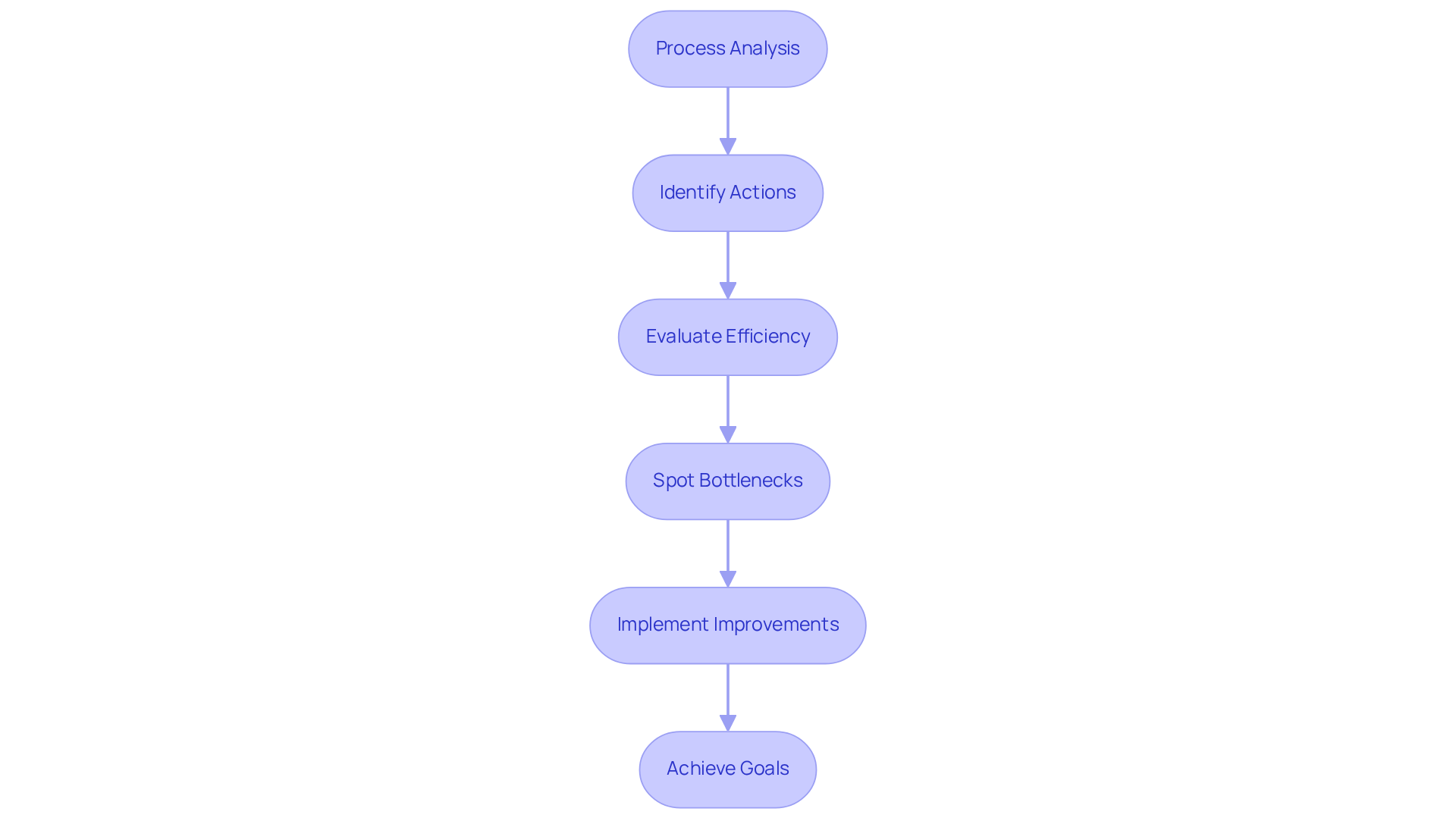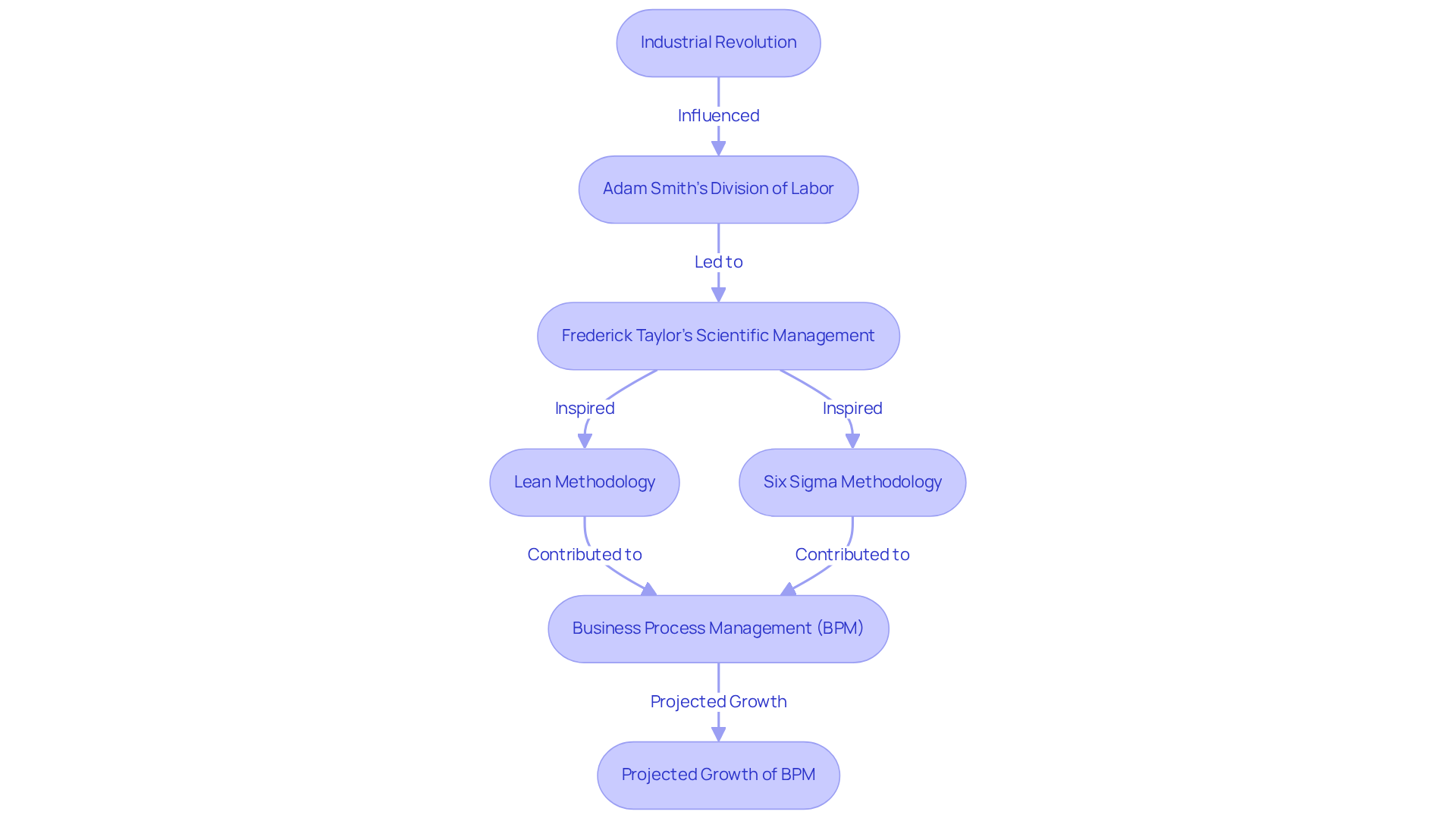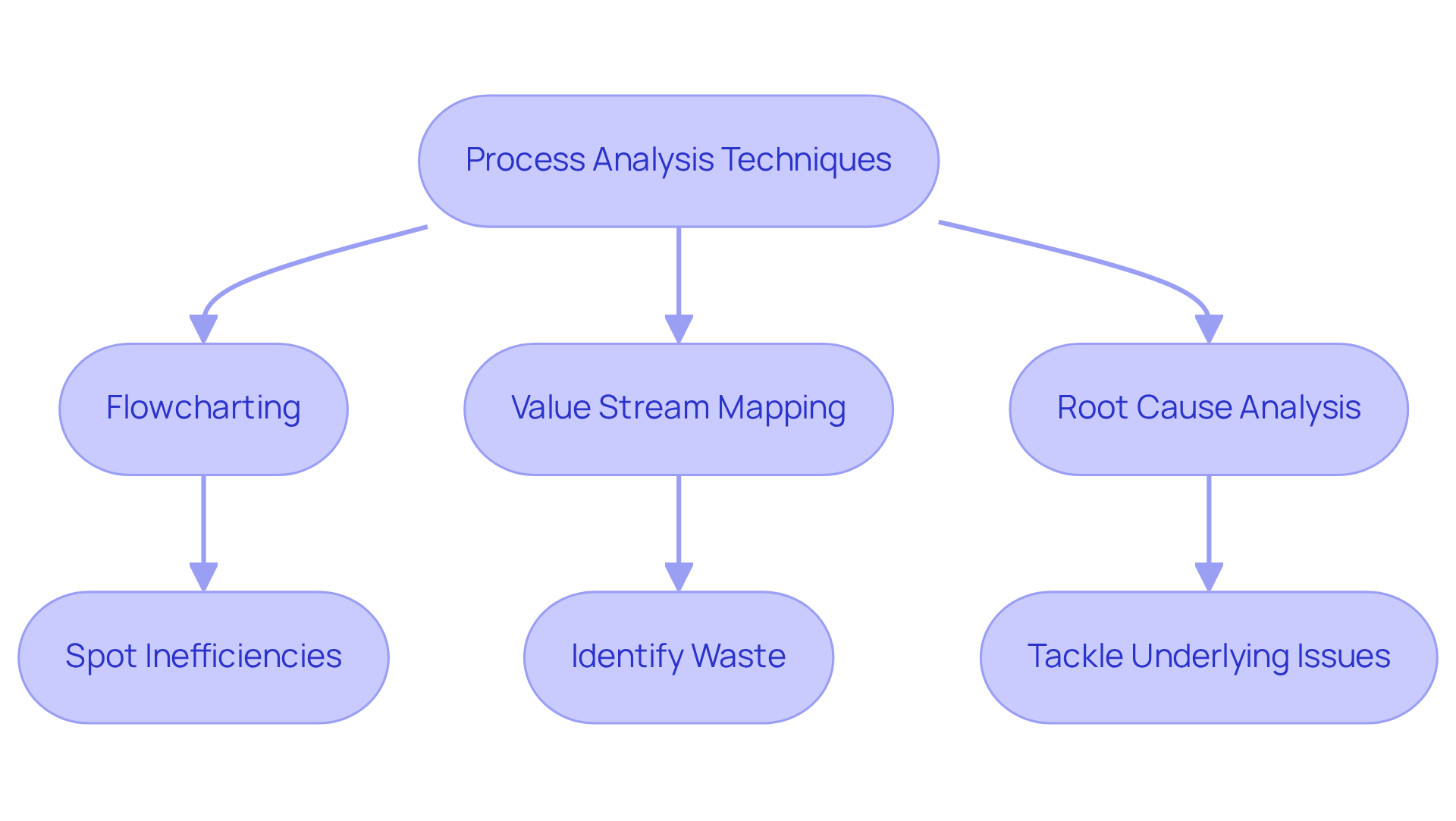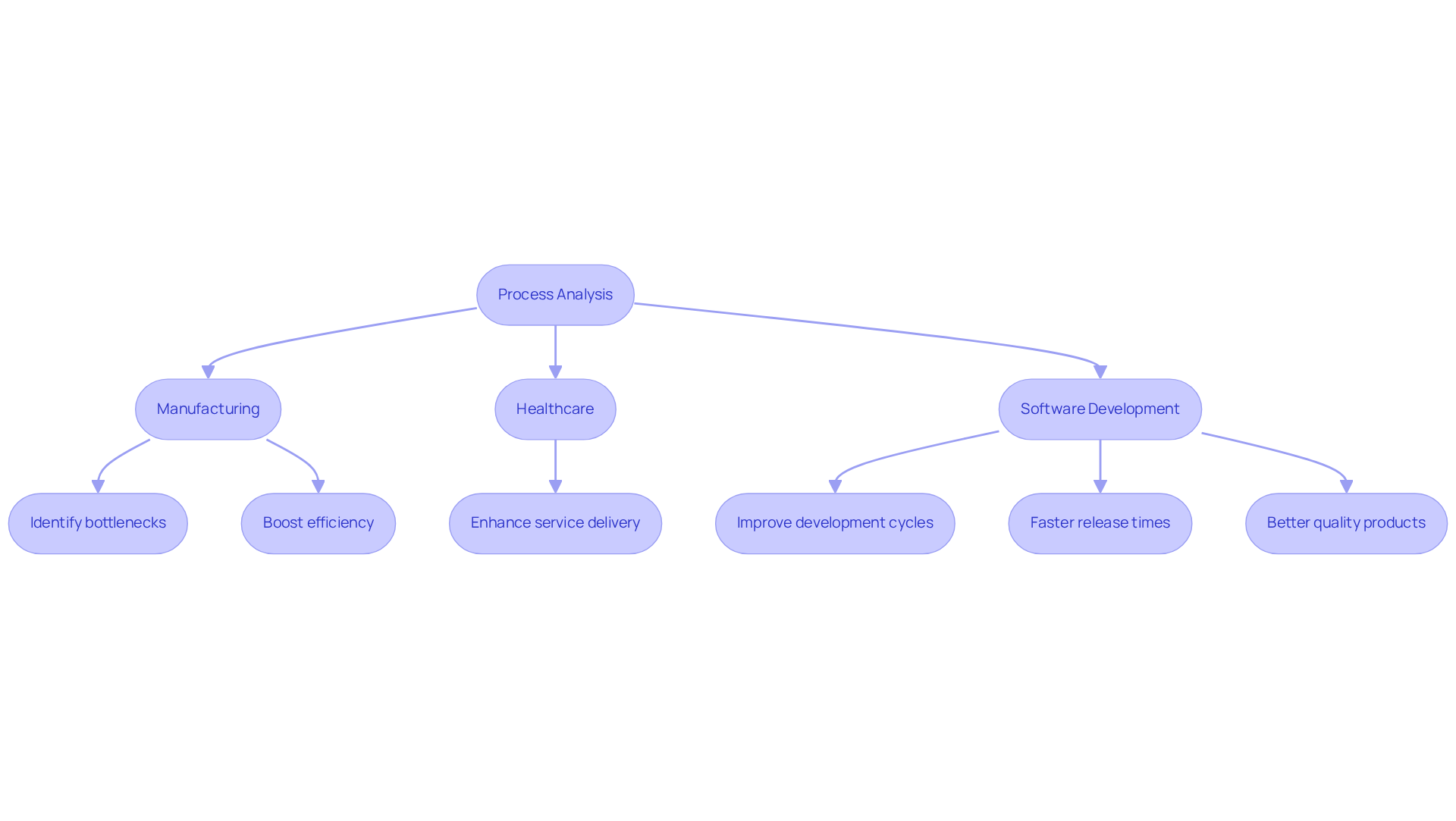
Automation and Documentation
|
October 16, 2025
|
Definition of Process Analysis: Importance, History, and Key Features
Overview
You might be wondering what process analysis is all about. Well, it's essentially a systematic look at how different actions connect to help us reach specific goals. This is super important because it helps us spot inefficiencies and boosts operational efficiency across various sectors. Did you know that the roots of process analysis go back to the Industrial Revolution? Fast forward to today, and we have modern methodologies like Lean and Six Sigma making waves. These approaches have practical applications in fields like manufacturing, healthcare, and software development, showcasing some impressive improvements in performance and cost reduction. So, let’s dive into how these methods can really make a difference!
Key Highlights:
- Process analysis involves systematically evaluating a series of connected actions to achieve specific goals, improving operational efficiency.
- Effective process evaluation can identify inefficiencies, bottlenecks, and areas for improvement, leading to cost reduction and enhanced performance.
- Historical roots of process analysis trace back to the Industrial Revolution, with contributions from figures like Adam Smith and Frederick Taylor.
- Modern methodologies such as Lean and Six Sigma emphasise continuous improvement and quality management in process analysis.
- Only 4% of companies with established procedures effectively manage and track performance, highlighting implementation challenges.
- Key techniques in process analysis include flowcharting, value stream mapping, and root cause analysis, which aid in identifying inefficiencies.
- Involving stakeholders in process analysis ensures a comprehensive assessment and better decision-making for improvements.
- Practical applications of process analysis span various sectors, enhancing efficiency in manufacturing, healthcare, and software development.
- Tools like SowFlow streamline documentation processes, fostering a culture of continuous improvement and efficient knowledge management.
Introduction
You might be wondering why understanding the intricacies of process analysis is so important for organizations aiming to boost their operational efficiency and adaptability. Well, this systematic approach does more than just identify inefficiencies and bottlenecks; it empowers teams to streamline workflows and enhance overall performance. But here's the kicker: a staggering 69% of companies find it tough to manage their established procedures effectively. So, what are the key characteristics and historical developments that have turned process analysis into a must-have for modern business strategy? Let’s dive into that!
Defining Process Analysis: Importance and Relevance
You might be wondering, what exactly is process evaluation? Well, it’s all about systematically looking at the definition of process analysis, which involves a series of connected actions that work together to achieve a specific goal. This is super important for spotting inefficiencies, bottlenecks, and areas where you can improve in your business operations. Why does this matter? Because the definition of process analysis indicates that effective process evaluation can really amp up your operational efficiency, cut costs, and boost overall performance.
Organizations can streamline their operations by breaking down complex systems into bite-sized pieces, which illustrates the definition of process analysis. Plus, it ensures that everyone on the team has clear and actionable information at their fingertips. In today’s fast-paced business world, where being agile and responsive is key, this couldn’t be more relevant. Now, let’s talk about how SowFlow’s innovative approach to documentation—think instant user guides and easy-to-use tools—makes workflow evaluation even smoother. This way, teams can manage knowledge effectively and adapt quickly to changing needs.

Historical Context: The Evolution of Process Analysis
You might be wondering where the idea of procedure evaluation even comes from. Well, it actually traces back to the Industrial Revolution, a time when manufacturing methods saw some serious upgrades. Pioneers like Adam Smith were all about the division of labor, which really boosted efficiency and productivity in factories. Then came Frederick Taylor, whose principles of Scientific Management shook things up by focusing on optimizing workflows and cutting out waste.
Now, here’s something to think about: in 69% of companies with established procedures, only 4% effectively managed and tracked performance. That really highlights the hurdles organizations face when trying to implement structured methodologies! As the years went by, new methodologies like Lean and Six Sigma popped up in the late 20th century, emphasizing continuous improvement and solid quality management practices.
Fast forward to today, and the definition of process analysis has become a key player in Business Process Management (BPM). It’s projected to grow from $11.84 billion in 2021 to a whopping $26.18 billion by 2028! This growth is all about helping organizations respond quickly to shifting market needs and tech advancements. So, this historical journey really shows us just how crucial structured methodologies are for boosting operational efficiency and adaptability.

Key Characteristics of Process Analysis: Components and Techniques
You might be wondering what process evaluation is all about. Well, it’s a systematic way to break down workflows, and it focuses on figuring out inputs, outputs, and performance metrics. Some key techniques that come into play here are:
- Flowcharting
- Value stream mapping
- Root cause analysis
Flowcharting gives you a visual snapshot of workflows, making it easier to spot inefficiencies and improving communication within your team. And then there’s value stream mapping, which shows how materials and information flow, helping you identify waste and optimize your operations.
Now, let’s talk about why involving stakeholders is so crucial in this process. By including different perspectives, you ensure a well-rounded assessment. This collaborative approach helps everyone understand workflows better, leading to more informed decisions for improvements. For instance, organizations that dive into root cause analysis can tackle those pesky underlying issues, resulting in significant boosts in operational efficiency. By using these techniques, businesses can streamline operations, cut down on cycle times, and ultimately enhance customer satisfaction. Just look at the companies that have successfully embraced these methodologies—they’re proof of the benefits you can reap!

Practical Applications: Examples of Process Analysis in Action
You might be wondering how the definition of process analysis can truly impact various sectors. Well, it's all about boosting efficiency and effectiveness! Take manufacturing, for instance. By examining workflows, companies can spot those pesky bottlenecks in production lines, leading to smoother operations and quicker lead times. And in healthcare, analyzing patient flow can enhance service delivery and keep patients happier.
Now, let’s dive into software creation. Here, workflow examination helps teams identify areas for improvement in their development cycles, which means faster release times and better quality products. Companies like Toyota and GE have really nailed the definition of process analysis, using it to drive continuous improvement and operational excellence. It’s a prime example of how practical this approach can be!
Have you heard of tools like SowFlow? They can completely transform how organizations handle documentation. Imagine being able to create SOPs and training materials in a snap! SowFlow allows users to document work efficiently, skipping the tedious screenshot captures. This means a seamless workflow that saves time and enhances knowledge management.
So, not only does this strategic support streamline documentation, but it also fosters a culture of continuous improvement. For operations managers looking to optimize their processes, it’s truly an invaluable asset. Don’t you think it’s time to explore how these tools can work for you?

Conclusion
You might be wondering why understanding process analysis is such a big deal for organizations looking to boost their operational efficiency and adaptability. Well, by taking a closer look at workflows, businesses can spot inefficiencies, cut costs, and ultimately enhance performance. Process analysis is all about streamlining operations and making informed decisions, which is more crucial than ever in today’s fast-paced business world.
Let’s take a step back and explore the historical context of process analysis. It all traces back to the Industrial Revolution, leading to the development of methodologies like Lean and Six Sigma. We also touched on key characteristics and techniques, such as flowcharting and root cause analysis, which are essential tools for breaking down complex processes into bite-sized pieces. Real-world applications have shown us the tangible benefits across various sectors—from manufacturing to healthcare—highlighting the importance of collaborative assessments that include stakeholder perspectives.
So, what does this mean for you? Organizations are encouraged to see process analysis as a strategic tool for continuous improvement. By embracing modern documentation tools and methodologies, businesses can create a culture of efficiency and responsiveness, setting themselves up for success in an ever-changing marketplace. Remember, the journey of process analysis isn’t just about understanding workflows; it’s about transforming them to drive sustainable growth and innovation. Now, isn’t that something worth diving into?
Frequently Asked Questions
What is process analysis?
Process analysis involves systematically examining a series of connected actions that work together to achieve a specific goal, helping to identify inefficiencies, bottlenecks, and areas for improvement in business operations.
Why is process analysis important?
It is important because effective process evaluation can enhance operational efficiency, reduce costs, and improve overall performance within an organization.
How does process analysis help organizations?
By breaking down complex systems into manageable parts, process analysis allows organizations to streamline operations and provide clear, actionable information to team members.
What role does documentation play in process analysis?
Innovative documentation approaches, like those offered by SowFlow, provide instant user guides and user-friendly tools, which facilitate smoother workflow evaluation and effective knowledge management.
How does process analysis relate to agility in business?
In a fast-paced business environment, process analysis is relevant as it helps teams adapt quickly to changing needs and maintain responsiveness.
👍
What others are liking
5 Steps to outline your ideal documentation structure
5 MINS READ
Where to start the your journey of mapping out your ideal documentation structure, aligning it with the very heartbeat of your organization?
Defining a winning level of detail in your process
3 MINS READ
What is too much detail, and what is too little? This article described in that winning level detail about what detail is enough.





